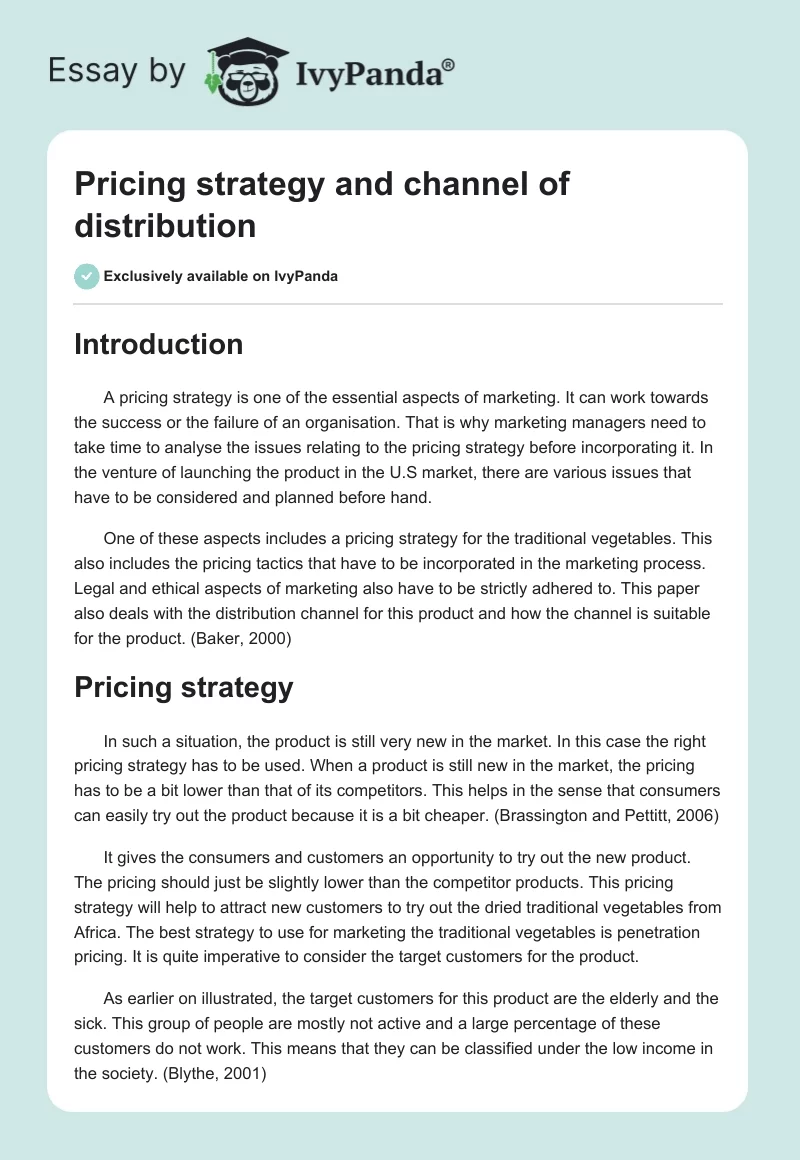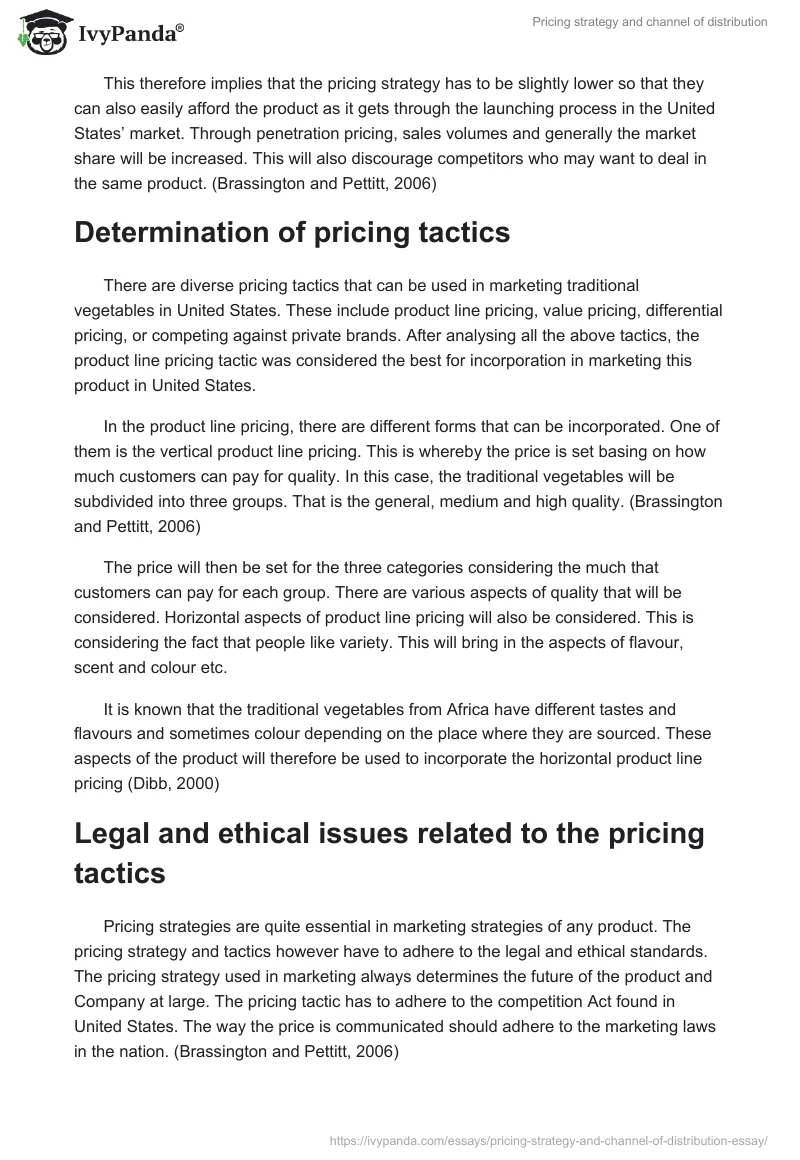Introduction
A pricing strategy is one of the essential aspects of marketing. It can work towards the success or the failure of an organisation. That is why marketing managers need to take time to analyse the issues relating to the pricing strategy before incorporating it. In the venture of launching the product in the U.S market, there are various issues that have to be considered and planned before hand.
One of these aspects includes a pricing strategy for the traditional vegetables. This also includes the pricing tactics that have to be incorporated in the marketing process. Legal and ethical aspects of marketing also have to be strictly adhered to. This paper also deals with the distribution channel for this product and how the channel is suitable for the product. (Baker, 2000)
Pricing strategy
In such a situation, the product is still very new in the market. In this case the right pricing strategy has to be used. When a product is still new in the market, the pricing has to be a bit lower than that of its competitors. This helps in the sense that consumers can easily try out the product because it is a bit cheaper. (Brassington and Pettitt, 2006)
It gives the consumers and customers an opportunity to try out the new product. The pricing should just be slightly lower than the competitor products. This pricing strategy will help to attract new customers to try out the dried traditional vegetables from Africa. The best strategy to use for marketing the traditional vegetables is penetration pricing. It is quite imperative to consider the target customers for the product.
As earlier on illustrated, the target customers for this product are the elderly and the sick. This group of people are mostly not active and a large percentage of these customers do not work. This means that they can be classified under the low income in the society. (Blythe, 2001)
This therefore implies that the pricing strategy has to be slightly lower so that they can also easily afford the product as it gets through the launching process in the United States’ market. Through penetration pricing, sales volumes and generally the market share will be increased. This will also discourage competitors who may want to deal in the same product. (Brassington and Pettitt, 2006)
Determination of pricing tactics
There are diverse pricing tactics that can be used in marketing traditional vegetables in United States. These include product line pricing, value pricing, differential pricing, or competing against private brands. After analysing all the above tactics, the product line pricing tactic was considered the best for incorporation in marketing this product in United States.
In the product line pricing, there are different forms that can be incorporated. One of them is the vertical product line pricing. This is whereby the price is set basing on how much customers can pay for quality. In this case, the traditional vegetables will be subdivided into three groups. That is the general, medium and high quality. (Brassington and Pettitt, 2006)
The price will then be set for the three categories considering the much that customers can pay for each group. There are various aspects of quality that will be considered. Horizontal aspects of product line pricing will also be considered. This is considering the fact that people like variety. This will bring in the aspects of flavour, scent and colour etc.
It is known that the traditional vegetables from Africa have different tastes and flavours and sometimes colour depending on the place where they are sourced. These aspects of the product will therefore be used to incorporate the horizontal product line pricing (Dibb, 2000)
Legal and ethical issues related to the pricing tactics
Pricing strategies are quite essential in marketing strategies of any product. The pricing strategy and tactics however have to adhere to the legal and ethical standards. The pricing strategy used in marketing always determines the future of the product and Company at large. The pricing tactic has to adhere to the competition Act found in United States. The way the price is communicated should adhere to the marketing laws in the nation. (Brassington and Pettitt, 2006)
Some of the ethical issues to consider relates to the effect of the pricing strategy on competition. The pricing strategy should not be too low such that the other competitor products would be highly disadvantaged. It is also quite ethical to consider the effect of the pricing tactic to the profitability of the Company.
The pricing strategy of traditional vegetables should not eventually lead to losses. The pricing strategy should also not be too high in such a way that is unfair to the customers. This is where the pricing tactic does not in any way relate to the ultimate value delivered to the customer.
Marketing distribution channel analysis
It is also essential to consider the marketing distribution channels for this product. In the venture to ensure that the target customers in United States access the vegetables, wholesaler to retailer then to the customer channel would be used. The wholesalers would be based in Africa and U.S.
They would get the dried traditional vegetables and directly send them to retail outlets. Wholesalers will easily be identified both in Africa and United states. All the wholesalers for this product will be identified online. The retail outlets will also be identified online and these are specifically those that deal with similar products. (Brassington and Pettitt, 2006)
Distribution strategy fits the product and overall marketing objectives
This distribution strategy highly suits the product to be launched in the U.S market. This is considering the fact that the dried traditional vegetables do not lose their nutritional value when they stay for a longer time. They can also take quite a long time before expiry as compared to the traditional vegetables.
This therefore shows that the channel of distribution best suits the product. The channel also suits the product since the final price would be quite affordable to the target group of customers. A longer channel of distribution results in high prices for the products. The overall marketing objective is to ensure that customers get to know about the new product, it will deliver quality for the benefit of the customers and the Company. (Palmer, 2004)
Conclusion
In conclusion, traditional vegetables are not easily accessible in United States. This unique product would help solve health problems found in the nation. Penetration pricing would be incorporated since the product is new in the market. Product line pricing tactic would also be used to reach the target population.
The distribution channel for this product would be manufacturer-wholesaler-retailer to consumer. This channel suits the product as it is not highly perishable. The overall marketing objective is to make the Company and products known in the market to the benefit of the customers and the organisation.
References
Baker, M. (2000): Marketing Management and Strategy; 3rd edition; New York; Macmillan Business
Blythe, J. (2001): Essentials of Marketing; 2nd edition, New York; Prentice Hall
Brassington, F. and Pettitt, S. (2006): Principles of marketing; 4th edition; Harlow; Prentice Hall
Dibb, M. (2000): Marketing Management and Strategy, 3rd edition: London. Macmillan Business
Palmer, A. (2004): Introduction to Marketing: Theory and practice, Oxford: Oxford University Press


